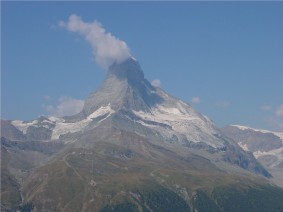Personal tools
News from ICTP 109 - What's New

ICTP's SAND group will coordinate an euro 2 million grant from the European Union to study the seismology of the Alps. Both the North and South are likely to benefit from the initiative.
Alpine Nation

More than its Roman ruins and
Renaissance cities, more than its medieval castles and meticulously
manicured agricultural landscape, more than its matchstick forests
and endlessly varied coastlines, the Alps--Europe's majestic mountain
chain that stretches some 1100 kilometres from southern France
in the west to Slovenia in the east--symbolise Europe's permanence
and solidity.
In fact, when you think of an immovable object, the Alps would
certainly qualify. Or so it seems.
But the truth is that the Alps are in constant motion, shifting
about 6 millimetres each year, as Africa continues to creep northward
in an endless display of nature's raw and relentless energy. The
result of this terrestrial 'give-and-take' is the creation of
spider-like fissures and fractures lying just beneath the surface.
This spring the European Union's Alpine Space Programme approved
funds for a 3-year Ý2 million grant to study how the Alps
are being reshaped by the daily stresses and strains that they
face. ICTP's SAND (Structure and Non-Linear Dynamics of the Earth)
group will coordinate the project, which will be housed at the
University of Trieste's Department of Earth Sciences.
"The purpose of the grant," says Giuliano F. Panza,
professor of seismology at the University of Trieste and head
of the SAND group, "is to try to understand how the Alps
have evolved over time and to make science-based projections about
what may happen to them in the future, especially in terms of
potential seismic activity."
"To meet the project's objectives," adds Karim Aoudia,
SAND research scientist and the project's principal investigator,
"we will rely on fundamental scientific tools.
"First, we will conduct a comprehensive review of existing
seismological studies of the Alps to literally acquire an in-depth
understanding of the current state of knowledge concerning the
behaviour of the Alps. Second, we will develop additional knowledge
about the region through the use of 30 high-precision ground positioning
satellite (GPS) receptors that will be put in place across the
Alps. And third we will use the information and knowledge that
we acquire both from the seismological studies and the GPS receptors
to build numerical models designed to simulate the behaviour of
the Alps both now and in the future."
The Alps are a relatively young mountain chain having emerged
from the ocean beds of western and central Europe more than 25
million years ago. Other mountain chains, including the Appalachian
Mountains in the eastern United States, are 250 million years
old. The endless fissures and fractures that characterise the
Alps, moreover, stand in sharp contrast to the gaping faults that
drive the behaviour of other mountain chains such as the Sierra
Nevadas in the western United States.
"The distinctive features of the Alps," notes Panza,
"create a distinctive set of challenges for researchers."
"First of all the Alps' spider-like fissures and fractures
mean that energy-release points are much more numerous in the
Alps than in many other mountain chains, including the Sierra
Nevadas where the San Andreas fault serves as the primary 'fault
line' in any seismic activity. Second, the Alps' numerous faults
mean that the motion often takes place in more subtle ways than
in other mountainous earthquake zones."
"For this reason," says Aoudia, "we will be using
instruments that can precisely measure motion at the millimetre
scale, marking the first time that scientists will have examined
the motion of mountains at this microscale."
Panza and Aoudia hope that their efforts will not only help improve
our understanding of the behaviour of the Alps but will shed light
on the behaviour of other earthquake-prone mountain regions as
well.
"We are confident that the information and skills we acquire
through this project can be utilizised by scientists throughout
the North and South. While the dynamics of the Alps may differ
from the Sierra Nevadas in the United States, they are quite similar,
for instance, to what we find in Asia," notes Panza. Substitute
the Himalayas for the Alps, India for Africa, and south central
Asia for western and central Europe, and you are essentially looking
at the same situation. India is slowly--nearly imperceptively--pushing
its weight northward creating stresses and strains on the Himalayas.
"As a result, what we do here," says Panza, "should
have applications in many other places of the world. That should
only increase the value of what we hope to accomplish over the
next few years."
For additional information about the ICTP SAND (Structure
and Non-Linear Dynamics of the Earth) programme, see http://www.ictp.it/pages/research/sand.html.